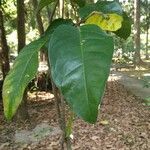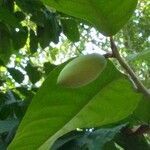Shrubs or small trees; bark grayish; crown narrow; branches becoming vinelike, green or yellowish green. Petiole 0.5-1.8 cm; leaf blade drying yellowish green, elliptic or oblong, 7.5-20 × 2.5-10 cm, leathery or membranous, lateral veins inconspicuous, curved, base attenuate into petiole, apex acuminate or cuspidate. Male inflorescences axillary, solitary, simple or once branched; male spikes (1-)3-6 cm × 2.5-3 mm, involucral collars clearly separated, to 1 cm apart, each collar with 50-80 flowers plus 5-15 globose sterile female flowers, basal hairs inconspicuous. Female inflorescences similar to male; nodes each with 5-8 female flowers. Seeds sessile or nearly so, yellow to orange-yellow or pink, ellipsoid, 1-2.5 (-3.5) × 0.9 (-1.5) cm, longitudinally ribbed, surface usually velvety, apex mucronate.
A shrub or small tree about 10 m high. It can grow to 20 m high. It normally has a cone shaped crown. The bark is greyish brown. The small branches are slender and like a vine. The leaves are produced in pairs opposite each other. They are dark green and shiny, oval and pointed at both ends. The leaves are 7.5-12.5 cm long by 2.5-7.5 cm wide. Trees are either male or female. Male spikes are 3-6 cm long. They consist of 50-80 very small flowers in rings along the stalk. Flowers are produced as cones made up of rings of scales along stalks 3-6 or 12 cm long. There are 5-8 flowers at each node. Fruits are oval and green when young but red when ripe. Fruit are 2-3 cm long and contain one seed.



